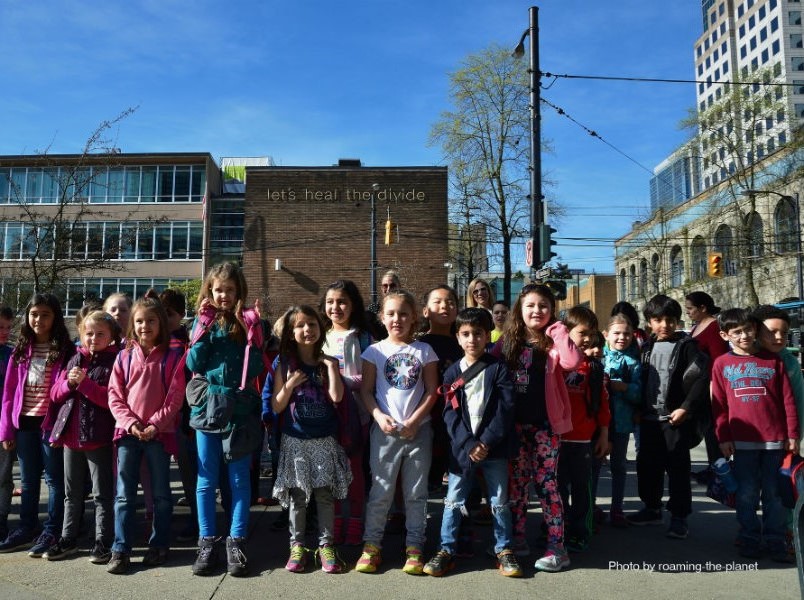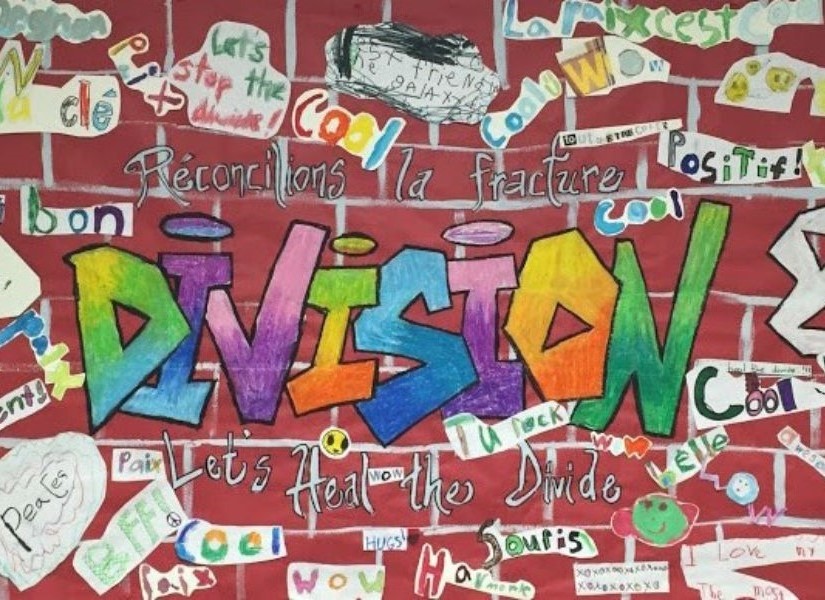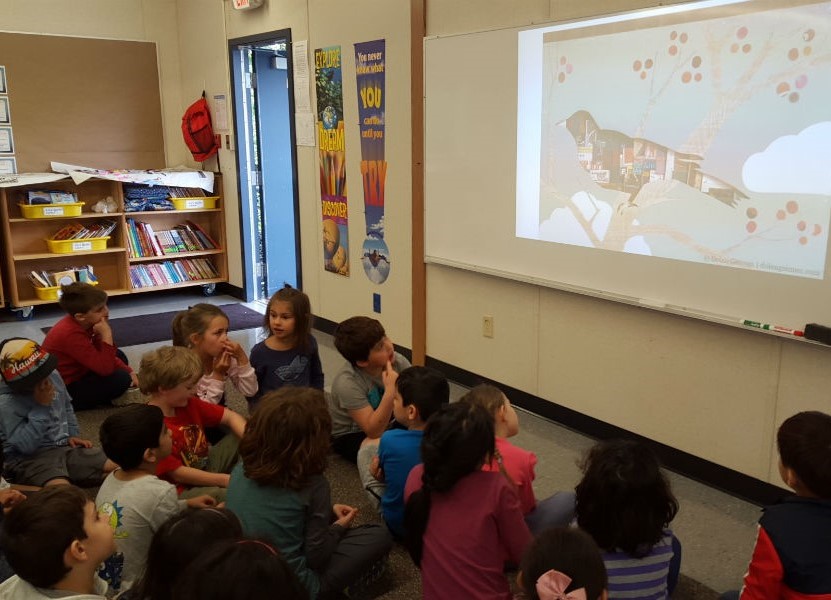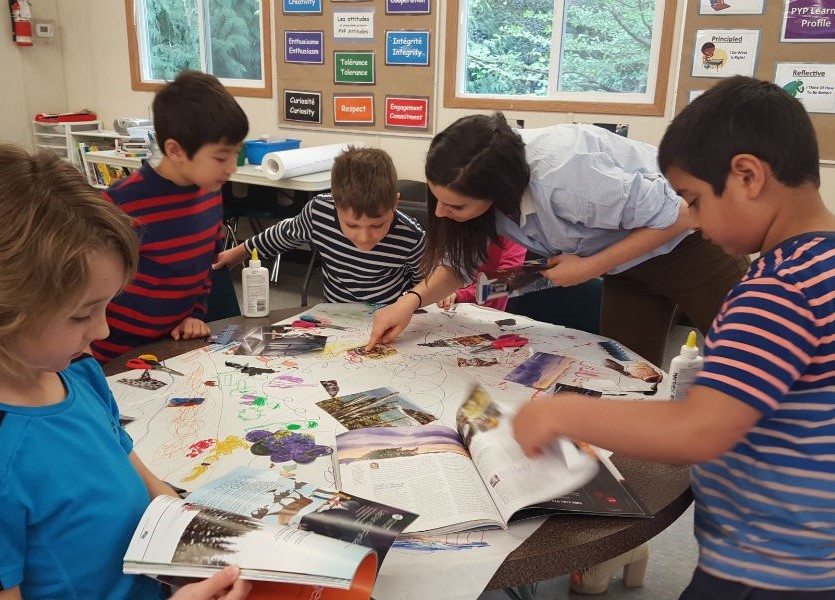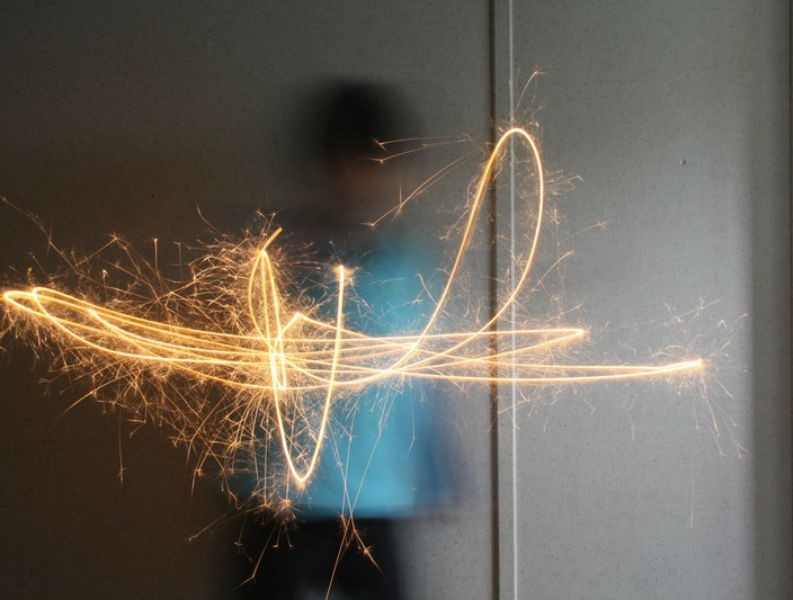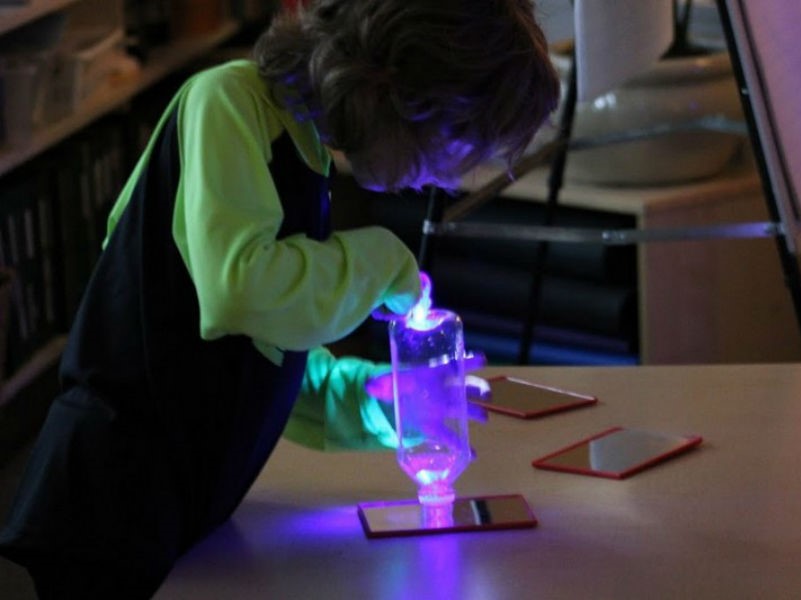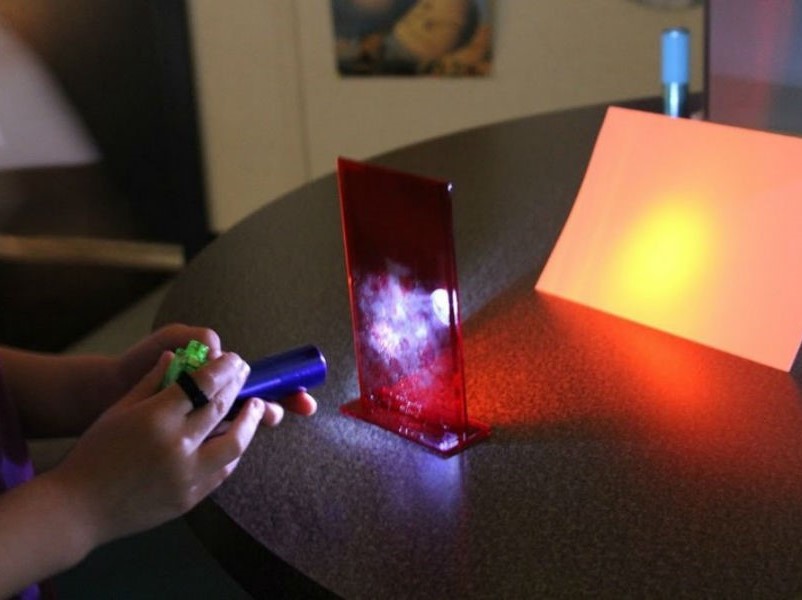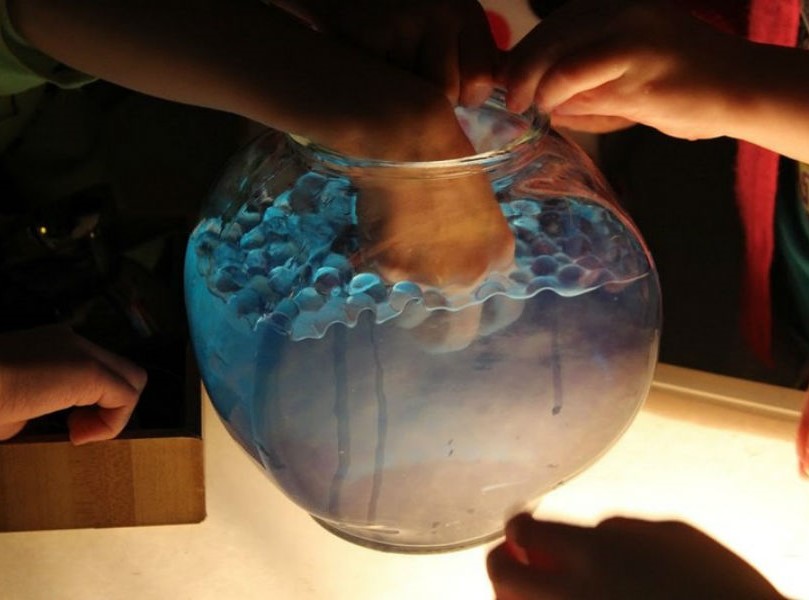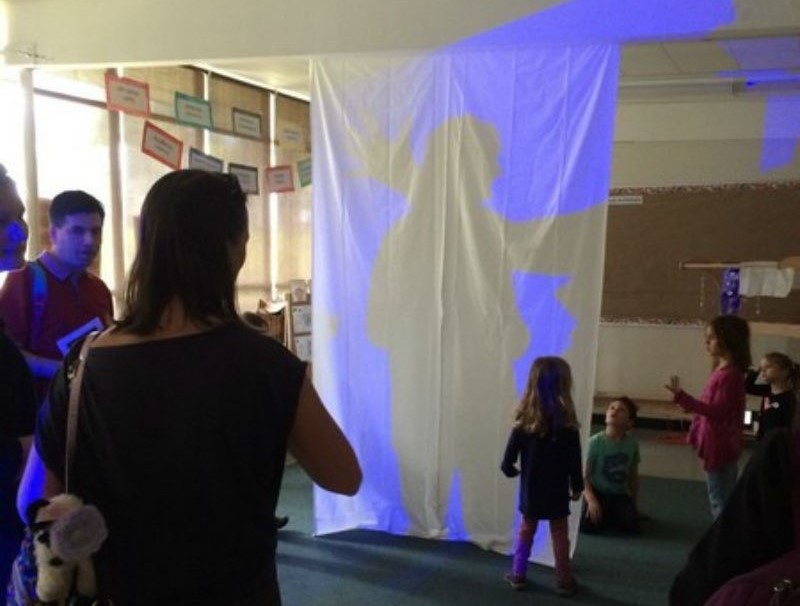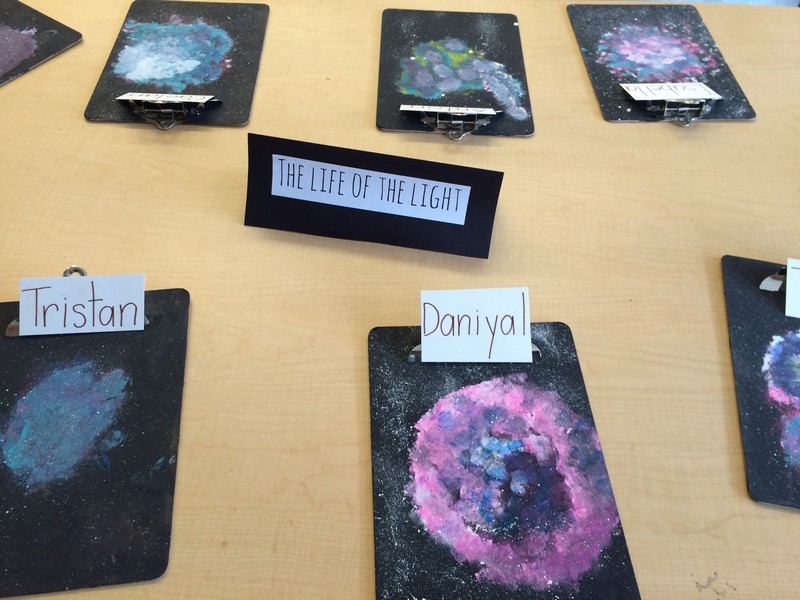École Cedardale: Ma lumière intérieure (The Light in Me)
Arts Education, Science, Social Studies
School: École Cedardale Elementary, West Vancouver
Teacher: Stina Morissette, Renelle Allard, and Chelsea Read
Artist Collaborators: Toni Latour
Class: Grade 1/2 French Immersion
Overview
Students inquired into how humans use light and sound to help tell their stories. The class visited Let’s Heal the Divide as a provocation to engage their thinking in the areas of social divide, the use of light as a medium for art and how art can communicate powerful messages and stories.
Connection to the Vancouver Biennale Exhibition
The class was inspired by Toni Latour’s piece, Let’s heal the divide. The teachers chose this project because they wanted to expose their students to the socio-economic disparity that divides East and West Vancouver, and they want the children in their classes to explore a different side of the coin. The teachers planned to discuss the differences between natural and artificial light, which forms of lighting are most environmentally stable, and explore why the artist chose to use neon lights. Her piece inspired a great deal of conversation amongst the collaboration team and they had the opportunity to explore the concepts of light, sound, and culture with the artist.
The students visited this installation in late March as a provocation to their Unit of Inquiry. The teachers envisioned this piece as a catalyst for learning in the areas of understanding how humans use light to communicate messages and share stories. Stories of differences, similarities, traditions and cultures.
BIG IDEAS
Humans use light and sound to help tell their stories.
Guiding Questions
- How can light and sound be used to share stories about various socio-economic contexts?
- How is human spirituality represented through light and sound in various cultures?
Cross-Curricular Access
- Aboriginal Education : Stories that involve light and sound to teach or share a message, Salmon life cycle, drumming circles discovery.
- Science & Art : neon lights in the city – effect on natural light & light pollution, Shadows – what is a shadow ? Where does it come from? Stars, planets, sun and moon as light sources.
- Music: Making noise, physically, figuratively and politically
- Science & Technology: how does light work? where does it come from? how does sound work? where does it come from?
Learning Process/Timeline
Week 1: Positive Messages
The students were first introduced to the big ideas of the project as well as to the artist. The artist brought in a maquette of her piece so that the students got to see the neon lights up close.
The artist presented the students with a slide and video show introducing them to the works that they would be visiting: let’s heal the divide (images and video), Martin Creed’s Everything is going to be alright, and Kristin McIver’s This Beautiful Day.
Inquiry Activities:
Feeling the Divide Exercise: The artist organized the students into two lines and had them feel the distance between each other. The class talked about a number of things they could do to heal that divide and become closer (ex. smiling, saying hello, or taking a step towards each other). The class came up with real life examples of what they could do to eliminate distance between them and their community.
After the workshop, students got a roll of mural paper and painted bricks to symbolize a wall. They then added positive messages onto that wall and used those words to dissolve the idea of a fence or border. Students had the idea of integrating english and french words together as opposed to separating them, demonstrating their understanding of project theme and incorporating positivity and inclusiveness.
Field trip – Healing the Divide
Students went on site to let’s heal the divide and the Andy Livingstone park near the Sun Yat Sen Gardens to see Martin Creed’s Everything is going to be alright. A docent from the Rennie Gallery met the class at the park to speak to the students about what that piece means to the neighbourhood during gentrification, and it’s potential for hope. She also provided some of the history of the Wing Sang building and the discrimination faced by Chinese Canadians. This reinforced the idea of racial and economic divides, and created opportunities for understanding, empathy and justice for the students.
The artist discussed with the students the the social and economic issues currently facing the downtown east side location. She spoke about the divide between areas of poverty and wealth in such close proximity and the background of how the site was chosen. The students explored what the location meant in terms of the takeaway message of the piece.
The artist recorded the sound of the children at the piece. They were very interested in the process involved in installing the piece.
The class also walked to a hill in a park a few blocks away to see the Martin Creed piece Everything is going to be alright from a different perspective. The artist discussed the history of the piece and its representation as neon light connecting it to the theme of the project.
Week 2 – Drawing with Light
The artist played classical music while the students got to move around to the song with sparkers in hand. She took long exposure photographs to produce an image that connected the students to the theme of the project “The Light in Me.”
These images were projected in the gym for the exhibition day along with the sound of the students from the field trip.
Week 3 – Soundscapes
The artist put together a collection of different soundscapes from around Vancouver (whales, skytrain, foghorn boats etc.). Students were to identify what they were hearing and in groups of 4-5 at tables and got to draw what they heard or how they felt while they were listening to it. As each soundscape progressed the artist added a new medium of art to include in their drawings (markers, pastels etc.)
She also showed them a few examples of mixed media pieces and demonstrated the power and effect of collaboration among artists.
Week 4 – Shadows and Storytelling
The students were introduced to shadow play with curtains, projector and a laptop. The artist read to them from a book about aboriginal animals of the west coast. She chose a different colour from each animal to project onto the screen. During each story the students went behind the screen and acted out different animals with shadows. The artist played an aboriginal soundtrack and narrated the story while giving stage advice to the students.
The artist took portraits of each of the students exhibiting four different emotions (Happy, Sad, Angry and Grumpy). The theme of the learning was “Identity, who are we?” While students waited to have their portrait taken they wrote stories about when they could remember feeling those emotions and drew illustrations. This aimed to tackle the guiding question: How can light and sound be used to share stories about various socio-economic contexts?
Week 5 & 6 Exhibition
The class had a celebratory art opening with students and parents. It began in the gym, then continued out into the hallways and classrooms. The exhibition included:
- A powerpoint slide show of the field trip, the positive messages, the sparkler images as well as the sound scape works and the shadow plays of the students being made.
- Sound scape collaborative drawings, exhibited in the hallway and gym.
- Emotion photo portraits of the students with their stories, exhibited in the hallway.
Inquiry challenges
The teachers focused their project on several inquiry questions to promote student curiosity and discovery. The following are examples of student focused inquiry questions they created to connect student learning to the guiding questions of the project.
Change:
How can light and sound be produced and how can their properties be changed?
How can students explore the properties of light and sound? (shadow work, shadow theatre, soundscapes, drumming)
How do light and sound change “the stories” of animals? (Salmon song, underwater sounds, echo activities)
Perspective:
How has the symbol of light been used across cultures?
What aspects of light and sound are important in various cultures?
How are light and sound represented in various cultures? Are important figures manifested through light and/or sound?
What do I value most and how can I express my beliefs with light and sound ?
What are the values of those around me? Do I have values in common with them?
What effect do various sounds and soundscapes have on our sense of self or well-being? How do mindfulness practices such as meditation,breathing and chanting help humans achieve spiritual well-being?
Reflection:
To what extent does lighting affect how we feel about a movie or performance? (films and performances)
To what extent does sound, soundtracks and sound effect affect how we feel about a movie, or performance?
What Aboriginal stories use light as a character? (storytelling and drama activities)
Whose story are we telling? Whose voice aren’t we hearing?
How are light and sound personified in stories?
How are stories from other places and times about me?
Light based technologies. (creating art with iPads, projections etc…)
Student Creation
The students created an art exhibition for their parents, teachers and schoolmates to see. The art opening displayed different projects that they created through inquiry based learning activities inspired by the artwork. These art pieces included:
- Long exposure photographs of the students taken by the artist.
- ‘Emotion-based portraits’ of each student taken by the artist paired with stories written by the students relating to their own experiences.
- Sound scape of the students visiting the artwork, created by the artist.
- Collaborative drawings created by the students inspired by different Vancouver sound scapes.
Reflection
Artist – Toni Latour
Artist Reflection on the Big Ideas work done at E’cole Cedardale, 2016:
The Big Ideas Project at L’ecole Cedardale began with the following guiding questions: How do humans use light and sound to share their stories. Who are we? (an exploration of self-identity). These questions were set against the Vancouver Biennale’s Big Ideas Program Theme: Art as a Catalyst for Learning.
Through our field trip and workshops, three classes of grade 1/2 students at L’ecole Cedardale explored how humans use light and sound to help tell their stories. They also learned about different socio-economic divides that exist in our local community.
Upon my first visit to the school, I gave a PowerPoint talk introducing the children to my Biennale piece “Let’s Heal the Divide”, and we did a group exercise where the children divided into 2 groups, facing each other, but far away enough that they couldn’t reach each other. As a group, they imagined different times in their lives when they felt a divide between themselves and other people, and then enacted several different ways in which they could come together: smiling at the person across from them, saying hello, taking a step closer, asking how the other person is, listening to the response, offering a hug. This was followed by a brainstorming exercise where the children came up with positive things they could say to someone on the playground, at home or at school. These activities created real world strategies connected to the concept of “Let’s Heal the Divide”.
Outside of my workshop, the children went on to illustrate these positive messages on mural that pictured a wall with text overtop. The text was in French and English, and the first idea was to put the French sentences on top and the English sentences below. And then the children said, no!, that would create another divide!, we should mix English with French. This was a key moment in learning integration and acceptance. A very proud and exciting moment.
The field trip to “Let’s Heal the Divide” followed that first class. The piece acted as a provocation to engage the students’ thinking in the areas of social divide, the use of light as a medium for art, and how art can communicate powerful messages and stories. They were very curious about how the work was mounted on the wall of VCC, along with the scale shift from seeing the 4 foot maquette in their classroom the week before, to the 30 foot ‘real life’ piece. It was during this field trip that the Vancouver Biennale’s Big Ideas Program Theme: Art as a Catalyst for Learning, really came into play. This neon artwork was to become the inspiration for all the art activities to come.
The children got to experience a neighborhood outside of their own where many diverse people live and work. A place that is at the centre of great wealth and poverty. We also walked over to a park to see Martin Creed’s piece “Everything is Going to Be Alright”. A docent from the Rennie Gallery met us there to speak to the children about what that piece means to the neighborhood during gentrification, and it’s potential for hope. She also provided some of the history of the Wing Sang building and the discrimination faced by Chinese Canadians. This reinforced the idea of racial and economic divides, and created opportunities for understanding, empathy and justice for the children.
Once the field trip was complete, it was time to make art! The children were able to explore artmaking with sound and light through several projects including long exposure photographs that I took of each child and group using sparklers. The children listened to classical music while waving their sparklers in the air like conductors. They were able to see their images right away on the DSLR and ask questions about how they are made and how it all works! While children waited for their turn, they worked on light and sound experiments the teachers put together. They then went on to make collaborative large scale multi-media pieces listening to soundscapes of Vancouver and beyond. They were stimulating many senses and working with many materials including tactile collage.
The following class explored how humans use sound and light to tell their stories. I read an Aboriginal book called “Sharing Our World: Animals of the Native Northwest Coast”. Incidentally, this coincided perfectly with the work of the carver in residence who is creating a house pole for L’ecole Cedardale. The children were witnessing and helping to carve this cedar pole earlier that day. Once the story was read, the children acted out their animal through shadow play using projected light and colour.
Identity was explored in the following 2 classes. This was done through portrait photography and an exploration of emotions. I photographed each child acting out 4 different emotions: happy, sad, grumpy and mad. Some needed coaching, so I asked them to close their eyes and imagine a time when they felt this way. Others were able to represent these emotions with their faces and bodies very easily. Over 400 photos were taken! While children awaited their photo session, they worked on a handout where they wrote stories in French about times they experienced this emotion. They also illustrated it with drawings. The following class, they put these 2 elements together in 1 work of art – 4 photos of each emotion, paired with text and drawing. This was our last art project!
On Thursday April 28, all the artwork the children made with me and with their teachers in relation to the Big Ideas Project was hung in the hallways, the classrooms and the gym, and the students and parents were able to see it all come together and celebrate their achievements! Many children were eager to help hang the show with me. Others were practicing their shadow plays set up in the classrooms. I put together a 260 slide PowerPoint that illustrated the whole 5-week project. It was projected in the gym. That afternoon had a palpable feeling of excitement, accomplishment and joy. The school was full of students and parents. The teachers and I addressed the group and explained what the children had done in the last 5 weeks. I was given a large card with notes and signatures, a bouquet of flowers and a gift for my new baby-to- come. It was such a lovely moment, full of love and gratitude. This experience has uplifted me. It reinvigorates me and my art practice to work with children. It gives me an opportunity to get my message out to young people who will shape our world. It also, so importantly, sends the message that art is valuable and has a great role to play in our lives. This is something vital for children to know.
The collaborative process of working with the Biennale and the teachers at L’ecole Cedardale was exceptional. The teachers and principal are so hard working, committed and open minded. I am astonished at the what they bring in to the school to expand the curriculum and the overall student experience. We all worked very hard in preparation and planning of this program, and the execution went off so smoothly. The students were active and engaged and a joy to work with. I would love to do this work again.
Credits
Photos at let’s heal the divide by roaming-the-planet
